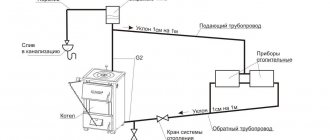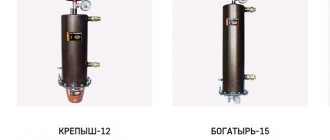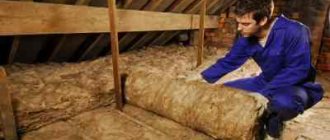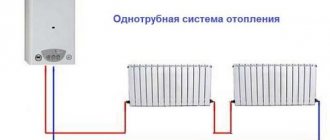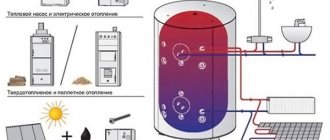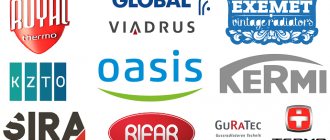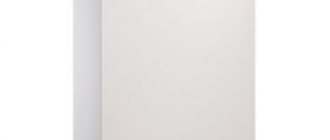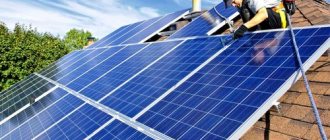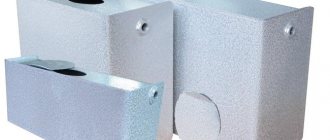Heat escapes through the roof of a private house. Heat loss can account for up to 30% of the total. To reduce heating costs, it is necessary to choose high-quality finishing materials and insulate the roof of a private house.
Insulation not only reduces heat loss, but also reduces heating costs in cold weather. Reliable insulation for the roof of a private house allows you to maintain a comfortable indoor temperature at any time of the year.
The need for roof insulation
High-quality insulation of the roof of a private house reduces the percentage of heat loss inside it. An ideal temperature is formed, which is easy to regulate without significant losses in heating or cooling the air with electrical appliances.
Incorrectly selected thermal insulators lead to poor quality insulation of the roof of a private house. In winter, ice forms on it and icicles form. Icing can compromise the integrity of roofing elements by causing leaks.
A poor-quality insulating layer can lead to dampness in the roof space of a private house. High humidity leads to the spread of fungus and mold. The wooden truss structure suffers, which swells over time and becomes unusable.
Foam glass
Refers to environmentally friendly materials for insulating the roof of a house. It has high thermal insulation properties. It is produced by foaming glass mass with carbon.
As a result, foam glass is resistant to deformation processes, moisture and steam, it is durable and non-flammable. This insulation is used to provide thermal insulation on all types of roofs, regardless of what materials they are made of. When installing foam glass, polymer acetate adhesive is used to ensure a high degree of adhesion.
The use of this insulation gives elasticity to the soft roofing covering and allows it to be leveled. This is one of the best options for thermal insulation of flat roofs that are planned to be used.
Which insulation can be considered the best, selection criteria?
The choice of thermal insulation material depends on the type of roof of a private house, which can be pitched or flat. The choice is made by analyzing the following parameters:
- Thermal conductivity. The lower the indicator, the higher the efficiency.
- Lifetime.
- Moisture resistance.
- Durability. How reliable are the insulation parameters?
- Environmental friendliness. No toxic substances should be used in the insulation.
- Frost resistance.
- Specific gravity. The best insulation materials have low density and do not weigh down the roof frame.
- Fire resistance.
- Soundproofing. Tile roofing requires high-quality insulation with maximum sound attenuation.
Good insulation keeps its shape throughout its entire service life, does not form voids and retains its thermal insulation properties for a long time, regardless of temperature changes.
Suitable for insulation
To insulate the roof of a private house use:
- Mineral wool . Fiber insulation is produced by combining molten and solidified rocks. It has excellent thermal insulation and sound insulation properties. Supplied in slabs or rolls, which are convenient to transport and install on site. During operation it does not shrink or change shape.
- Glass wool . Mineral wool is created on the basis of fiberglass. It is made by melting cullet or quartz sand. Keeps its shape perfectly, does not allow sounds to pass through, and retains heat. Can withstand temperature loads up to 500 degrees. It is sold in slabs or rolls.
- Polyurethane foam . Polyurethane foam insulation is a liquid that, during the production process, enters into a chemical reaction and foams. As a result, a solid substance with a porous structure is formed, which perfectly insulates the surface. Polyurethane foam has high thermal insulation properties due to its airtight surface coating. It is able to adhere firmly to any base and does not emit harmful and toxic substances.
- Expanded clay . Bulk insulation consists of porous clay granules that are light in weight and come in various sizes. It has a reduced thermal conductivity coefficient and a high level of sound absorption. It is environmentally friendly, non-flammable, therefore it is also used for insulating interfloor and attic floors.
- Penoizol . Properties are similar to polyurethane foam. The difference is that penoizol has slightly higher characteristics and a lower cost. It is easy to install and completely safe for health. To insulate with penoizol, it is necessary to use foam-forming equipment to reduce the weight of the structure. In addition, before spraying this material, you must first lay a vapor barrier layer to reduce the degree of moisture absorption.
- Foam concrete . It consists of cement, concrete, sand and a special agent that gives the material a porous structure. Foam concrete creates a strong and durable structure with low density. It retains heat perfectly and does not place high loads on the supporting frame. For laying, a mobile installation is used, which controls the thickness of the laid layer. Its size should not exceed 15 cm and not be less than 3 cm.
- Expanded clay . Bulk insulation, which is placed on floor slabs or on the outer surface of the roof. The heat insulator is pre-insulated and then covered with screed. Expanded clay creates a load on the foundation being laid, so its use must be carefully calculated and verified with the design documentation for a private house.
- Foam glass . Environmentally friendly insulator with high thermal insulation characteristics. Resistant to deformation and exposure to steam and moisture. Durable, non-flammable and can be used on any roofing materials. Polymer acetate glue is used for installation.
Not recommended for use
There are many roofing insulation products on sale that experts do not recommend using. This is due to their side effects. Their list is as follows:
- Ecowool . Good insulation with a huge drawback. Ecowool is made from a highly flammable component - cellulose fiber. Despite the treatment with fire retardants, its flammability is very high, and over time it shrinks and loses its original qualities. This material cannot be used to insulate the roof of a private house.
- Sawdust . Eco-friendly material, but not safe from a fire safety point of view. In addition, sawdust is a favorable environment for various microorganisms, small insects and even rodents. It absorbs moisture well, therefore creating an environment for rotting and mold growth. Over time, it shrinks, which leads to a decrease in thermal insulation properties.
- Expanded polystyrene . It consists of slabs that cannot withstand high temperatures above zero. Already at 80 degrees, polystyrene foam releases toxic substances that are dangerous to human health. It is allowed to lay this material only under plaster or screed made of concrete or cement.
Glass wool
This well-proven thermal insulator has technical characteristics similar to mineral wool. In the production of glass wool, glass melt is used.
It is sold on the construction market in rolls and in the form of slabs. This is an environmentally friendly insulation material with good soundproofing qualities. When installing a heat-insulating layer using glass wool, roofers use protective clothing and special equipment and follow safety precautions so as not to cause harm to health.
Before insulating the roof of a private house using mineral wool, you need to select a vapor barrier material, and at the same time, glass wool slabs may already have a foil coating on the outside - its presence simplifies the installation of the thermal insulation layer.
Comparison of the main characteristics of thermal insulators
| Insulation | Density kg/cub.m | Thermal conductivity W/(m*K) | Flammability |
| Minvata | 35 — 40 | 0,035 — 0,039 | NG |
| Glass wool | 15 — 20 | 0,035 — 0,042 | NG |
| Polyurethane foam | 60 — 80 | 0,023 — 0,032 | NG |
| Expanded clay | 300 — 500 | 0,09 — 0,1 | NG |
| Ecowool | 38 — 41 | 0,038 — 0,041 | G2 |
| Styrofoam | 10 — 37 | 0,033 — 0,041 | G1 |
| Extruded polystyrene foam | 26 — 32 | 0,028 — 0,031 | G4 |
| Sawdust | 0,10 — 0,25 | 0,07 — 0,09 | G3 |
Composition and scope of the material
Erection of the roof is an important stage that largely determines the comfort and safety of living in the house. In order for the structure to properly perform its protective function, during construction it is necessary to adhere to the installation technology. The composition of the roofing cake, which includes thermal insulation, also becomes important. A competent choice of thermal insulator will help to significantly reduce heat loss, and, therefore, reduce future costs of heating the house.
The modern market offers a wide range of insulation materials with a different set of qualities, but with one similar parameter - low thermal conductivity. Among insulation materials, Izover “Warm Roof” is popular - a material whose scope of application covers all types of buildings, including public buildings (hospitals and kindergartens), residential buildings and country cottages.
Thermal insulation of the attic Source build-blog.ru
Isover is an improved type of mineral wool made from glass or basalt fibers. The group's materials include recycled natural components: basalt rocks, quartz sand or broken glass. Recommended areas of application are pitched roofs and attics. It is allowed to be used for thermal insulation of vertical walls (external and internal), on floors along joists and ceilings.
The best insulation for an attic roof
For the attic roof of a private house, it is important to provide high-quality insulation to reduce heat loss. Good thermal insulation must have vapor permeability and low thermal conductivity to ensure high-quality air circulation.
Rockwool Light Butts Scandic
Light Butts Scandic is one of the lightest Rockwool insulations, with compression up to 70%. Elasticity is created by stone fibers running at the base of the slabs. Good elasticity and a high coefficient of compression allow the wool to easily fit between the rafters and naturally straighten after completion of work.
For your information! Excellently fills the space between frame elements and prevents cold air flows. Suitable for insulating pitched roofs and attic spaces, balconies, partitions and ceilings.
Rockwool produces Light Butts Scandic insulation in two size variations:
- Standard. 800*600 mm, thickness 550 or 100 mm.
- 1200*600 mm, thickness 100 or 150 mm.
Paroc eXtra
Mineral non-combustible basalt insulation produced in a slab. Its thickness varies from 40 to 250 mm. It is a kind of middle ground between stone wool and fiberglass, but Paroc eXtra fibers are much longer than classic materials.
For production, only high-quality and homogeneous raw materials are used, which ensures the elasticity and flexibility of the slab. During installation, mineral non-combustible basalt insulation does not break or roll into the structure; it is easily implanted into the spacer.
Paroc eXtra slabs are sold slightly pressed in sealed packaging. When it is opened, the shape of the plates is restored. It is not flammable and has high sound insulation ability.
Consumer Reviews
Review of Linerock “Light effect” insulation:
More details on Otzovik: https://otzovik.com/review_1208058.html
Linerock Light effect
Review of ISOROC mineral wool thermal insulation:
More details on Otzovik: https://otzovik.com/review_7134354.html
mineral wool ISOROC
Another review about ISOROC mineral wool thermal insulation:
More details on Otzovik: https://otzovik.com/review_3951910.html
Review of Penoplex thermal insulation boards:
More details on Otzovik: https://otzovik.com/review_3959072.html
Penoplex slabs
Penoplex slabs
Review of ISOROC mineral wool thermal insulation:More details on Otzovik: https://otzovik.com/review_5193087.html
The best insulation for a pitched roof
For pitched roofs of a private house, high-quality and durable heat insulators are used. This is due to the need to protect the roof from loads and exposure to heat and moisture.
Isover C-000176898
Quartz-based mineral slabs are suitable for insulating attics and pitched roofs. The insulation has a special coating that ensures its shape remains unchanged. This also makes it possible to facilitate installation work, which is difficult due to the strong slope of the structures.
A special feature of Isover C-000176898 is that the material is suitable for insulating the roofs of a private house with different rafter spacing, is environmentally friendly and does not emit toxic substances when heated. When laying, it does not crumble and does not create dust. It has enhanced protection against moisture and steam, and also effectively absorbs noise.
HeatKnauf TR 037 Aquastatik
Created on the basis of basalt wool. The composition contains special fiberglass, which is mixed with components that provide the binder and water-repellent properties of the insulation. HeatKnauf TR 037 Aquastatik has low sound conductivity and a long service life.
It is convenient during installation, as it has excellent elasticity. This allows you to insert it into the spacer without distortion. It cuts and bends beautifully. It is non-flammable and safe for human health, as it is produced without the use of phenol-formaldehyde and acrylic resins.
HeatKnauf TR 037 Aquastatik is coated with water-repellent impregnation, which guarantees its reliability and durability.
Is the most popular one suitable? - Styrofoam
It is worth mentioning that by foam plastic we mean both ordinary, white polystyrene foam (PSB-15) and extruded polystyrene foam, the density of which can reach 35-45 kg per cubic meter.
So, PSB-15 is not used for flat roofs. Although it is much cheaper, it can still be damaged when installing insulation by simply stepping on the sheet. In addition, the foam is made without a quarter. But, for example, penoplex has special grooves at the edges that are fastened together and create one indestructible layer of insulation on the plane.
The ceiling of a cold roof is often insulated with foam plastic in the frame when it is laid between the joists. For the same purposes, more moisture-resistant polystyrene foam is used, which, by the way, has much greater compressive strength.
The issue of using this material for a residential floor under the roof was discussed separately, and this is generally a whole topic.
Thermal insulation materials start with polystyrene foam. But, alas, it does not qualify for the title of best insulation for roofs. That's why they mentioned it at the very beginning. Further - more interesting. [flat_ab id=”34"]
The best insulation for a flat roof
The technology for insulating flat roofs of a private house differs from pitched roofs. Firstly, there is no need to nail the sheathing, which would form a ventilation gap for ventilation. Secondly, it is necessary to use products that are glued to the underlying base and coating.
TechnoNIKOL Carbon Eco
Extruded polystyrene foam is a heat insulator with evenly distributed and closed cells. This ensures high-quality insulation and long service life of such a coating. TechnoNIKOL Carbon Eco does not absorb moisture and does not swell. It does not shrink and is also resistant to chemicals and rotting processes.
Super strength allows for a smooth and at the same time rigid base during installation. This provides a guarantee of quality and operational reliability. The slabs are packaged in durable bases covered with stabilized film.
When insulating the roof of a private house, first of all you should pay attention to the roofing material. Based on this, you can choose the highest quality and most suitable insulation that meets the declared qualities. You shouldn't skimp. It is important to insulate the roof efficiently and for a long time to avoid heat losses.
Content
We bring to your attention the video:
Let's put it this way: each technology has its pros and cons, and which insulation to choose for your roof depends on what you want to get in the end: environmental friendliness, manufacturability or durability? After all, each of us has our own priorities, and each product has its own buyer.
Frequent errors that occur during installation
Lack of proper insulation installation technology can lead to the following negative consequences:
- The formation of “cold bridges” occurs when the integrity of the “roofing pie” is violated (for example, the cracks between the insulation are not sealed with moisture-resistant mastic),
- The formation of many icicles on the eaves in winter - this is caused by the penetration of warm air from the room through the roof of a private house, which leads to melting of snow,
- An increase in heat loss occurs when installing thermal insulation in a damp state or when carrying out work in a damp environment.
There are many materials on the market for insulating the roofs of a private house. The correct choice of insulation will ensure a comfortable temperature in the house, the absence of toxic emissions, reduced heating costs in winter and air conditioning in summer.
Manufacturers
On the market you can find materials for insulation of domestic production, as well as insulation from the USA, Finland, Germany, France and other countries.
The following brands are available:
- TechnoNikol;
- Knauf;
- Isoroc;
- Isover;
- Paroc;
- Rockwool;
- Ruspanel;
- Soudal;
- Tytan;
- Ursa;
- Akterm;
- Penoplex;
- Penofol;
- Tepofol;
- Tilit;
- And others.
Go to any well-known online store and use filters to look at the characteristics of each individual product.
As you can see, there are very different methods of insulation, but price always remains an important issue.
Property No. 1. Thermal conductivity
Choosing good insulation for your roof primarily depends on how severe the winters are in your area. So, if you live in the southern region of Russia and your winters are as warm and mild as in Europe, you can easily get by with their recommendations: just take one insulation you like, install it according to the instructions and don’t worry about anything else. But if your winters are long and quite frosty, you won’t be able to do it with just one simple solution.
You will be surprised, but polystyrene foam has the lowest thermal conductivity:
Property No. 5. Biological safety
Biological safety is a more understandable term, which states that insulation should not be a breeding ground for various fungi and microorganisms. As well as in itself – pose a threat to the human body.
For example, thanks to special chemical treatment, fashionable ecowool is truly not susceptible to any fungi. Moreover, rodents do not breed in such an environment either. Insulated - and you don’t need to worry about anything:
Video description
The video shows what polystyrene foam chips are and where they are used today:
As for the insulation of a pitched roof along wooden rafters, the crumbs are used almost like ecowool, filling the space between the rafter legs with the material. They just do it manually in stages. That is:
- cover the rafter system from the attic to a height of 1-2 m, for example, with plywood;
- fill the space limited by plywood sheets and roofing material;
- coating, polystyrene foam granules;
- install the next sheet in height;
- carry out filling;
- and in this way all the way to the top.
You can also backfill granular insulation from the side of the roof. To do this, you will have to cover the rafters from the inside of the attic with boards or sheets, and fill the material itself from the street. And only then, after the process is completed, begin the installation of the roofing and other necessary layers.
Today the process is mechanized and automated, that is, the material is supplied using pressurized air and hoses.
Filling the space of the roof structure with polystyrene chips Source besplatka.ua
Property No. 4. Chemical resistance
But the presence of such an insulation parameter as chemical resistance usually does not arouse much interest among ordinary buyers who simply decide to insulate the roof of their house themselves. What other resistance is there, and where on the roof will the chemicals come from? Why pay extra for this quality if you simply don’t need it? Well, at first glance?
In reality, everything is not so simple. No matter what kind of roof we insulate, the insulation always touches a whitewashed wall, a metal surface, antiseptic-treated rafters, and many other surfaces somewhere. And a chemical reaction of such touches always occurs, invisible to the eye. And it is important that the insulation itself does not corrode, i.e. gradually deteriorate.
Here a lot depends on the insulation of the insulation itself. For example, in this regard, new innovative panels as insulation are encouraging. One of the leading brands is, of course, Izover. This product consists of a multi-layer insulated core made of quartz filler and an aluminum film around it. Additionally, a thick sealing tape is applied, which acts as a tight connection with the strips. On both sides, another layer is often used - solid MDF plates 3 mm thick.

